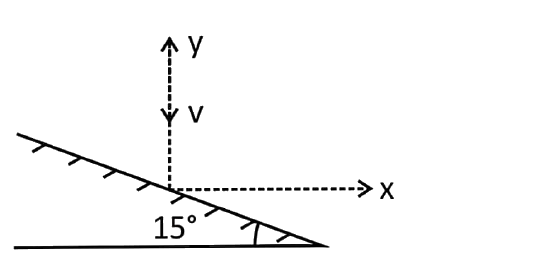An object is moving on a plane surface with uniform velocity 10ms−1 in presence of a force 10N. The frictional force between the object and the surface is
1 N
−10 N
10 N
100 N
To solve the problem, we need to analyze the forces acting on the object moving with uniform velocity.
1. Understanding Uniform Velocity:
The object is moving with a uniform velocity of 10m/s. This means that the velocity is constant, and therefore, the acceleration of the object is 0m/s2.
Hint: Recall that uniform velocity indicates no change in speed or direction, which implies zero acceleration.
2. Applying Newton's First Law:
According to Newton's first law, if an object is in motion with a constant velocity, the net force acting on it must be zero. This means that all the forces acting on the object must balance each other out.
Hint: Remember that for an object to maintain constant velocity, the net external force must equal zero.
3. Identifying the Forces:
In this scenario, there is an external force of 10N acting on the object. Since the net force is zero, there must be a frictional force acting in the opposite direction to this external force.
Hint: Think about how forces interact; if one force is applied, there must be an opposing force to maintain equilibrium.
4. Calculating the Frictional Force:
Since the external force is 10N to the right, the frictional force must be 10N to the left to balance it out. Therefore, the frictional force is 10N in the opposite direction.
Hint: The magnitude of the frictional force will be equal to the applied force when the object is in equilibrium.
5. Conclusion:
The frictional force between the object and the surface is 10N acting in the opposite direction to the applied force.
Final Answer: The frictional force is 10N (to the left).
The object is moving with a uniform velocity of 10m/s. This means that the velocity is constant, and therefore, the acceleration of the object is 0m/s2.
According to Newton's first law, if an object is in motion with a constant velocity, the net force acting on it must be zero. This means that all the forces acting on the object must balance each other out.
In this scenario, there is an external force of 10N acting on the object. Since the net force is zero, there must be a frictional force acting in the opposite direction to this external force.
Since the external force is 10N to the right, the frictional force must be 10N to the left to balance it out. Therefore, the frictional force is 10N in the opposite direction.
The frictional force between the object and the surface is 10N acting in the opposite direction to the applied force.
Topper's Solved these Questions
- LAWS OF MOTIONBOOK - AAKASH INSTITUTE ENGLISHCHAPTER - LAWS OF MOTIONEXERCISE - Assignment (SECTION-D) (Assertion-Reason Type Questions)
15 Videos
- LAWS OF MOTIONBOOK - AAKASH INSTITUTE ENGLISHCHAPTER - LAWS OF MOTIONEXERCISE - Assignment (SECTION-B)
44 Videos
- KINETIC THEORYBOOK - AAKASH INSTITUTE ENGLISHCHAPTER - KINETIC THEORYEXERCISE - EXERCISE (ASSIGNMENT) SECTION - D Assertion - Reason Type Questions
10 Videos
- MAGNETISM AND MATTER BOOK - AAKASH INSTITUTE ENGLISHCHAPTER - MAGNETISM AND MATTER EXERCISE - ASSIGNMENT (SECTION D)
26 Videos
Similar Questions
With increase of temperature, the frictional force acting between two surfaces
View SolutionAn object of mass 1 kg moving on a horizontal surface with initial velocity 8 m/s comes to rest after 10 s. If one wants to keep the object moving on the same surface with velocity 8 m/s the force required is
View Solution
Knowledge Check
The frictional force between two surfaces is independent of
ANature of the surfaceBSize of the bodyCArea of contactDMass of the body
An object is moving towards a mirror with a velocity of 10ms−1 as shown in the figure. If the collision between the mirror and the object is perfectly elastic, then the velocity of the image after collision with mirror in vector form is

View SolutionWrite the formula to find the magnitude of the gravitational force between the Earth and an object on the surface of the Earth.
View SolutionThe velocity - time (V - t) graph of an object of mass 2 kg is as shown in figure while it is moving on a rough horizontal surface. The coefficient of friction between object and the surface is (g=10ms2)
View SolutionForce can move an object at rest.
View SolutionA block moving on a horizontal surface with velocity 20ms−1 comes to rest because of surface friction over a distance of 40 m. Taking g=10ms−2 , the coefficient of dynamic friction is :
View SolutionA body of mass 2kg moving on a horizontal surface with an initial velocity of 4ms−1 comes to rest after 2 second. If one wants to keep this body moving on the same surface with a velocity of 4ms−1 the force required is
View SolutionA body of mass 5 kg moving on a horizontal surface with a velocity of 10ms−1 comes to rest in 2s. The force required to make this body move with a velocity of 10ms−1 on the same surface is
View Solution
